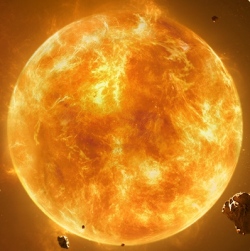
SolO will take pictures and measurements from inside the orbit of Mercury, to gain new insights on what drives the star’s dynamic behaviour.
The European Space Agency has signed a contract with Astrium UK to build the satellite, for a launch in 2017.
The deal is valued at 300m euros (£245m).
That makes it one of the biggest ever contracts placed in the UK by the Paris-based agency.
With an eye on history, the signatures on the legal paperwork were timed to coincide with the 50th anniversary of UK activity in orbit.
Twenty-six April 1962 was the day Britain became a space-faring nation with the launch of its first satellite, Ariel-1.
Esa director Alvaro Gimenez and Astrium executive Miranda Mills shook hands on the SolO project in London’s Science Museum, where a model of Ariel-1 is on display.
After launch, Solar Orbiter will take itself deep into the inner Solar System, flying as close as 42 million km from the Sun.
It will require the spacecraft to carry a robust heatshield, the Sun-facing side of which will experience temperatures approaching 600 degrees.
SolO’s remote sensing instruments – its imagers and telescopes – will look though slots which have shutters that can be closed when no observations are being made.
The mission is designed to enhance our understanding of how the Sun influences its environment, and in particular how it generates and accelerates the flow of charged particles in which the planets are bathed.
This solar wind can be very turbulent, and big eruptions on the solar surface will create major perturbations in the wind. When this stream of particles hits the atmosphere at Earth and the other planets, it triggers spectacular auroral lights.
Solar Orbiter will be close enough to the Sun to directly sample the solar wind just after it has been ejected from the solar surface, and it has five in-situ instruments for the purpose.
The probe’s orbit will also take it high above the plane of the planets so it can see some of the processes at play on the Sun poles. And the speed of SolO around the star means it will be able to follow events and features that would normally rotate out of view of Earth-based observatories.
At the heart of the endeavour is a desire to understand better the causes of what solar physicists call "space weather".
Big storms on the Sun that hurl billions of tonnes of charged particles out into space can disturb electromagnetic fields on Earth, resulting in communications interference and, in extreme cases, damage to power lines and satellite electronics.
Scientists would like to be able to forecast such events earlier and with more confidence.
Solar Oribter is a joint venture between Esa and the US space agency (Nasa). The latter will supply two instruments and the rocket to send the satellite on its way.
The project emerged for a competition among European space scientists to find the most compelling medium-class mission to take an available launch slot at the end of the decade.
Esa will soon sign off a second such mission, called Euclid, which will investigate the mysterious phenomena known as dark energy and dark matter, which appear dominate and shape the Universe we see through telescopes.
The first in a new class of large missions (those cost a billion euros or more) will be selected next week. This is expected to be a mission to study the icy moons of Jupiter.
